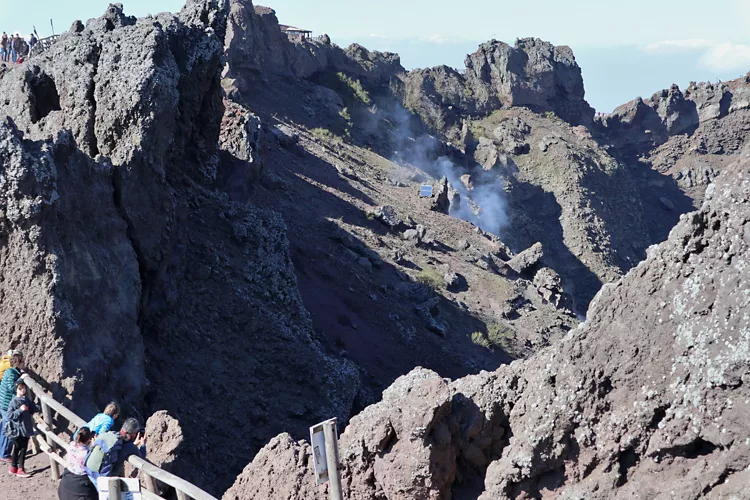This content was automatically translated. View the original text.

Overview
The Vesuvius National Park, a land of fire and rebirth
Vesuvius National Park protects the territory of the only active volcano in continental Europe, the symbol of the city of Naples.
An ascent along its slopes, amidst the scent of broom and the smell of sulphur, offers the thrill of looking out over the crater of the Gran Cono, in a landscape marked by the geological formations shaped by the last eruption in 1944. This is a unique territory, rich in the archaeological treasures of Pompeii and Herculaneum, and the fruits of an exceptionally fertile land.
A spectacular caldera with an active volcanic cone
Visiting the Vesuvius National Park allows you to take a stroll through at least two million years of history. The great caldera of Somma is what remains of an ancient volcano three hundred thousand years ago, and inside it is the Gran Cono del Vesuvio (1281 metres), with its typical truncated cone shape, a diameter of 450 metres and a depth of 300 metres. Inside it there are small fumaroles that reveal its state of 'active rest'.
Along path number 5 traced on the ashes and lapilli of the last eruption, that of 1944, one can admire the inside of the crater. Having conquered the summit, visitors are rewarded by a magnificent view of the gulf and the city of Naples. There are 11 paths in all. Number 9 allows you to observe how the vegetation is regaining its hold on the 20th century lava flows of 1906, 1929 and 1944.
How pioneer plants get the better of lava
Despite the succession of eruptions, the slopes of Vesuvius are covered with dense vegetation that has reformed on the lava flows due to the phenomenon of 'ecological succession': when the lava cools, the first to colonise it are lichens and mosses, the so-called pioneer species. These are very hardy organisms that form an initial organic substrate on which more complex organisms such as ferns or some graminaceous plants can begin to develop, in turn creating a layer for plants with more complex root systems.
Today, a grey, filamentous lichen (Stereocaulon vesuvianum) can be observed on the areas affected by the most recent eruptions, which prepares the ground for other plants, while older flows feature shrub species such as helichrysum, cistus, mugwort and red valerian.
The next stage is that of broom, large expanses of which can be seen colouring Vesuvius yellow in the springtime. The different stages of the 'ecological succession' can be clearly observed along path number 3, where sections of still exposed lava are flanked by areas colonised by lichen, alternating with broom and holm oak woods.
What to visit in the Vesuvius National Park
After hiking to the crater, inside the Vesuvius National Park you can visit the Park Museum in the municipality of Boscoreale, where plastic models are on display that illustrate the evolution of the volcano, materials showing the special features of the soil and biodiversity, as well as the story of the complex interaction between human populations and the volcanic environment.
In Boscoreale there is an archaeological museum, the Antiquarium, explaining the territory of Vesuvius before the eruption in 79 AD that affected Pompeii and Herculaneum.
In the latter location is the world's first volcanological Observatory, created in the 19th century for the first research and measurements of seismic activity, with its original instruments.
Among the municipalities on the slopes of Vesuvius, it may be interesting to visit Borgo Casamale in Somma Vesuviana, the only medieval quarter left in the area; Terzigno, an area where lava stone was worked, where a museum has been opened with the archaeological remains of several Roman villas; and in Torre del Greco, visit Villa le Ginestre, where the poet Giacomo Leopardi was hosted.
The good products of a fertile land
Lacryma Christi is a white and red DOC wine produced from various vines grown on the slopes of Vesuvius, whose palatability has been known since Roman times.
There are also apricots, about 40 varieties of which are grown in the area; they are known to be sweet and tasty, and the secret always lies in the volcanic soils which are so rich in minerals, especially potassium.
The same can be said of the Monte cherry, with its pinkish-yellow fruit and pale, firm flesh, and the Catalanesca grape, so called because it was imported from Catalonia by Alfonso of Aragon in the 15th century. It has the distinctive quality of remaining intact on the vine until Christmas.
You cannot leave the park without having tasted (or bought) the Piennolo del Vesuvio DOP cherry tomatoes, harvested in clusters: hung in well-dried places, they can last for up to 7-8 months, from summer until the following spring, preserving their intense flavour that derives from a high concentration of sugars and a wealth of organic acids.
What makes the area of the Vesuvius National Park one of the most fascinating and most visited places in the world is a mix of natural treasures, breath-taking landscapes, centuries-old cultivations, popular traditions and much more.